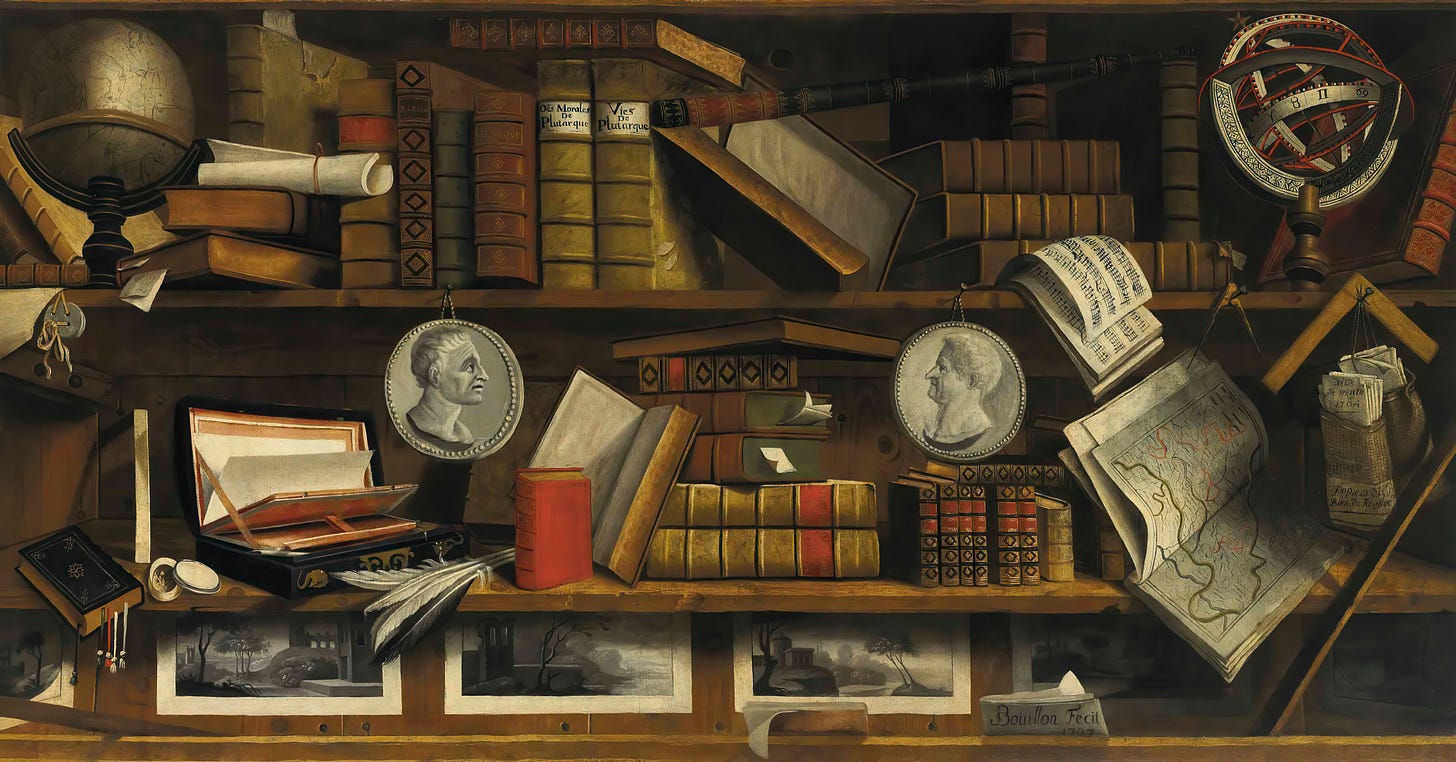This Weekend Edition of Ecstatic features Bailey Gillespie
After eight years of rewriting a literary nonfiction manuscript, I recently signed with Westwood Creative Artists, one of the oldest literary agencies in Canada. Ekstasis generously invited me to share about the experience because their publication played a special role in the journey.
ON THE Habit Podcast, Jonathan Rogers once interviewed Andrew T. Le Peau who formerly worked at a noteworthy Christian publishing house. Le Peau referenced an essay by T. S. Eliot called “Tradition and the Individual Talent,” encouraging writers not to fixate on originality but to find joy in contributing to an existing tradition.
Everything we make builds on the past. Ideas, materials, words. “What the artist, or what the writer, does is try to make a contribution to the tradition—try to add to it, or give it a little twist, or help us see it in a slightly different perspective,” said Le Peau. It’s freeing to acknowledge we aren’t working from scratch. Instead, we have the joy of getting our hands dirty in the soil of good literature.
On the wall of our living room are two floating shelves that my dad and I built in his woodworking shed. These shelves are reserved for only the best books in our home: 30 literary companions—poetry, essays, memoirs, novels—that mark each season of life. I’m a firm believer that books find you right when you need them. When I consider the impact these authors have had on my life and spiritual formation, T. S. Eliot’s theory rings true. It would be the highest honor to add to the tradition on these shelves, companioning even one person on their faith journey as these authors have done for me.
UNFORTUNATELY, THE JOURNEY to create my own book to put up on that shelf was full of more pitfalls and false starts than I could have imagined. Once upon a time, I sat next to author and illustrator John Hendrix at an arts conference. He scribbled away, transforming lecture notes into a masterpiece of words and images. It looked like chaos—but, as the British like to describe their flower gardens, it was “beautifully ordered chaos.” My favorite sketch from his portfolio is How to Survive the Arc of Every Long Project. It’s relatable, to say the least.
Despite the ominous imagery, which gives Pilgrim’s Progress vibes, this sketch is a great comfort. It reminds me that life, writing, and healing are not linear, and struggle is normal. For a time, I pinned this illustration to the wall above my writing desk as an icon to remind myself that laughter is medicine and persistence matters.
I’ve hit the Pit of Despair more times than I can count while drafting a book, frustrated by a story’s potential and my inability to reach it. I’ve wanted to give up. But there it was again—that still small voice whispering to keep going. My 85-year-old friend Loretta calls this voice a deep knowing. It’s the voice of the Holy Spirit. For over a decade, I’ve listened and held onto this dream, hoping for a longer thread to this whole book-writing business.
There are other places where I experienced deep fulfillment in writing. In my day jobs and the poems I wrote for church liturgy. In prayer journals and letters. In devotions and women’s health articles. But there was something distinct about this book project that fueled my creative life. I’ve discovered that completing a long project is less about the result and more about the formation that happens when you remain steady on a course, despite emerging obstacles. As Justin McRoberts says, “It’s not about you, and it’s not about you making great work. It’s about you becoming the kind of person who makes great work.”
Inspired by other local friends who landed book deals after years of closed doors, I want to be someone who cultivates patient endurance, whether the book deal comes or not. Someone who commits to the long game in faith, relationships, health, and creative work. Most careers begin right after college. But I’m learning that many writers operate on a reverse timeline, publishing in their 40s, 50s, or 60s, aging their words with time and maturity like fine wine.
I PENNED THE FIRST WORDS to what is now my book manuscript back in 2009 as a prayer, journaling through heartbreak. Writing is indeed a healing spiritual practice. Inside a cathedral of pine trees and California poppies, I wrote my heart out in a mini spiral-bound notebook that was crinkled from blackberry juice and salt water. Jesus was faithful to meet me there, comforting me while I filled the pages. This confirmed an early belief that God draws near to us in our sorrow—a belief that has been challenged many times as I’ve also wrestled with God’s seeming silence and moments that feel more like divine neglect. But writing remains the practice that softens me, drawing my eyes outward again.
In the book of Joshua, God commands the Israelites to use stones as symbols of remembrance to mark his presence on their journey. Once they cross the Jordan River, Jacob says, “When your children ask their fathers in times to come, ‘What do these stones mean?’ then you shall let your children know, ‘Israel passed over this Jordan on dry ground.’ For the Lord your God dried up the waters...” (4:21-23). Growing up near the Coloma River Valley, the Gold Rush discovery site, I’ve always loved the imagery of memorial stones. Stacked along the river banks are dozens of tiny stone towers known as cairns. Although they are merely artwork today, erected by whitewater rafting guides, in ancient times these towers stood as markers or burial mounds. They said: “Look! Something significant happened here.”
Like stone-stacking, writing is an act of remembrance. Stories are the memorial stones. Storytelling is a way to bear witness, to mark what happened, and to weave something new and golden and beautiful from the shards of what was broken or lost. It’s kintsugi for word-spinners. Many of us don’t understand what we think or feel about a given thing until we write our way through it. It takes patience. Illumination comes when we’re willing to sit with an idea or a feeling as it unfolds. We discover the truth about God and ourselves one line, one word at a time.
QUERYING LITERARY AGENTS can be discouraging. I've spoken with four agents before who graciously turned me down. One said to come back when I had 5,000-10,000 Instagram followers. Then one month ago, Ekstasis published my essay, The Millennial Dream Dash on their Substack. The essay was essentially my book’s plot and themes condensed into a single piece. I was delighted by the thoughtful comments, direct messages, and follows from people who also know what it’s like to live with deferred hopes and dreams. Teary, I took screenshots of each message and added them to my phone’s Encouragement folder. One young woman wrote: “I kept thinking, ‘That’s me!’... Your words made me feel like I can keep pressing on despite the trials, sufferings, and unknowns: that God will meet me there, and life can still be beautiful and messy.”
Three days after the essay was published, an agent who subscribed to Ekstasis emailed me, asking if I already had a book deal or was interested in representation. I almost fell off the couch. As a matter of fact, I typed, astonished by this unexpected turn of events. After sending her my book proposal and sample chapters, we had a 90-minute phone call that ended with her extending an offer to sign an agreement. After nearly a decade of work, prayer, tears, and beginning over and over again, I couldn’t be more grateful that God has finally opened a door into publishing.
BEFORE GIVING MY AGENT an answer, I took two weeks to pray. The next few months would require a lot of unpaid work, and things are tight for my husband and I right now as he finishes a ministry degree. I was also unsure if writing about my experience with chronic pain and illness was the best choice for my well-being. Then I remembered how often, in moments of struggle, I reach for my pen—which is reaching for hope—and write my way out of the darkness. This isn’t going away. Ultimately, I want to be a woman driven by Christ despite doubts, illness, marketplace trends, or any other obstacle. And so I opened my laptop and typed these words to Bridgette: “My official response is: YES! I would wholeheartedly love to sign with you.”
For the writers: As John Hendrix suggests, persistence is key. Pay attention to your deep knowings. Keep working, keep waiting, keep showing up. Despite the cliche, it is integral to trust your process and enjoy the journey. Oh, and don’t forget to guest post. Agents and publishers want to see that you’re actively engaging with topics you care about in the marketplace. And you never know who might be on the other side of the mailing list.
Bailey Gillespie
Writer & Podcast Host
Bailey is a writer from Northern California. After a career in higher education and publishing, she now hosts a podcast called Listen to Your Life and cares deeply about helping millennials walk in hope and well-being. Besides writing, she enjoys road trips to the coast, good stories, farmers markets, and cooking. Bailey regularly contributes to other publications and has written on art, women’s health, and spiritual formation for IAPMD Global, She Reads Truth, The Rabbit Room, and Jessup University. You can follow her on Instagram @baileylgillespie and find her on Substack at baileygillespie.substack.com.
What did you think of this essay? Share your thoughts with a comment!













Bailey, this is so encouraging. Thank you for sharing your experience ❤️ congratulations!!
I am beyond encouraged here. As a graphic artist and communications designer of 30+ years, I'm entering a similar experience, tapping into an invitation to explore the calling card of God: beauty. Your story has reminded me that the ultimate outcome of this journey is not necessarily an audience to share with (although that can be part of it) but our Divine companion throughout it all and the depths and heights we get to explore with God through the act of creating. Thank you for building this cairn for this fellow traveler to find.